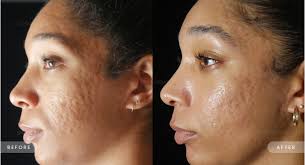
How long does it take to get rid of acne?
How long it takes to get rid of acne depends upon what skin care routine you are using, how consistently you use it, and what is causing your acne. If you are doing everything right, it takes about 8 weeks to clear acne.
Acne takes much longer to get rid of than most people realize. You may get impatient and stop using your acne products before the acne medications have a chance to work. So this is my advice as a dermatologist:
Know your Baumann Skin Type
Build a routine to match your skin type
Use it consistently
Wait 4- 8 weeks before expecting improvement
Then once the acne clears, you must get rid of acne marks such as red marks and dark spots that can take months to fade. Acne scars, which are different than red marks and dark spots, will not fade on their own.
How you treat your acne will determine whether or not you develop red marks, dark spots and acne scarring- so be diligent about your acne treatments and make sure you are using the best skin care routine for your skin type.
How long does it take to get rid of acne marks?
Acne marks will not fade until you treat the underlying cause of acne.
Once the cause of acne has been eliminated it will take 8 weeks to stop breaking out and get rid of acne if you are using the best acne products to treat your skin concerns. It can take many more months for acne marks to fade.
If you have a sudden outbreak of pimples, it will take about 2 – 4 weeks for those to clear if the cause has been removed. For example, if you break out because you used a new skin care product or makeup with acne-causing ingredients, but you stop using the problem product, it can take 2-4 weeks for the pimples to clear naturally without any acne treatments.
How long to get rid of acne depends upon your skin care routine and habits and sunscreen use.
If your acne will not go away and you have tried everything, make sure that:
You are using the right skin care products for your Baumann Skin Type
You are using a custom acne routine and all the products have been chosen to work well together
You are using the skin care routine every morning and night as directed
Your retinoid serum is not expired or inactive due to exposure to light or air
You are not using products with acne causing comedogenic ingredients
You are not taking testosterone which causes acne
You are not taking Vitamins B6 or B12 which can cause acne
You do not have any hormone imbalances
If you are using the right products for your Baumann Skin Type consistently, then acne should begin to clear in 8 weeks.
Take the skin type quiz to make sure you are using the right acne skin care routine.
Take the Quiz
How long does it take for acne marks to fade?
There are 3 main types of acne marks on the skin after acne clears:
red marks
dark spots
acne scars
Many of my patients call the red acne marks scars, but they are not true scars and will go away. However, a scar may develop in the same area that the acne mark was.
How can you tell the difference between a red acne mark and a scar? A red acne mark is flat and looks pink or red but not glistening or shiny or firm. The skin over an acne scar feels firmer than normal skin or is depressed in various shapes such as ice pick marks (narrow deep round punctures) or box cars which have lagged edges. Acne scars may look lighter than the surrounding skin and may have a glistening appearance. Acne scars can also turn into keloids.
How to Get Rid of Red Marks From Acne
red acne marks can take months to fade
Red marks from acne can take months to go away. They are red because the blood vessels are enlarged to help bring nutrients to the are so you do not want to use vasoconstricting anti-redness serums or creams with hydrocortisone to clear them. In the long run, this will take more time to get rid of the red acne marks. Although I do not usually recommend it unless you have a wedding or important event, a vascular laser can help clear red marks from acne. These red marks are not acne scars. They will go away with time. If they are depressed or thick or you pick at them, they can turn into acne scars which are very hard to get rid of.
How Long to Clear Dark Spots from Acne?
dark spots can take 8 to 12 weeks to fade
Dark spots from acne are a form of hyperpigmentation that occurs from the inflammation that is characteristic of acne.
It is also called PIH, PIPA, or post inflammatory hyperpigmentation.
Acne dark spots are harder to get rid of in darker skin types.
The best way to erase dark marks from acne is with skin lightening ingredients such as tyrosinase inhibitors.
It can take 12-16 weeks for dark spots from acne to clear.
Read here how to clear skin faster and why it takes so long to clear dark spots.
Why does it take so long to fade acne marks?
Acne is a disorder of the hair follicles. Pores clog and pimples from deep down in the hair follicle.
It takes time for the hair follicles to clear and normalize.
hair follicle where acne begins
The epidermis that lines the hair follicle plays an important role in acne because of the desquamation cycle.
You can learn more about desquamation here.
The epidermal desquamation process gets messed up. This is called dyskeratinization. Basically this means the dead skin cells hold onto each other and do not flake off of the skin way they should.
This occurs for several reasons:
activation of toll like receptor 2
presence of bacteria
dysfunction of enzymes
increased oil (sebum)
dyskeratinization from over-exfoliation
It takes weeks for the desquamation cycle to normalize once you begin the right acne skin care. Then it takes about 30-45 days for all of the “messed up” epidermal keratinocytes to move to the skin’s surface and flake off of the skin.
Acne will keep recurring until the keratinization process is normal again and all of the messed up keratinocytes have been replaced. This can take 8 weeks.
How to prevent acne marks?
You cannot fade and prevent acne marks unless you stop getting pimples.
Using the right skin care EVERY day is the only way to prevent the recurrence of acne.
Keep using your regimen- even after your acne clears.
Take the quiz to find the best routing to prevent red acee marks and dark spots. Also- do not forget your sunscreen!


